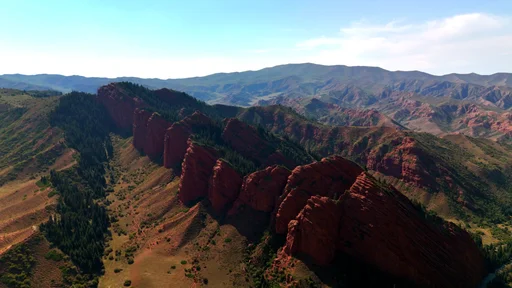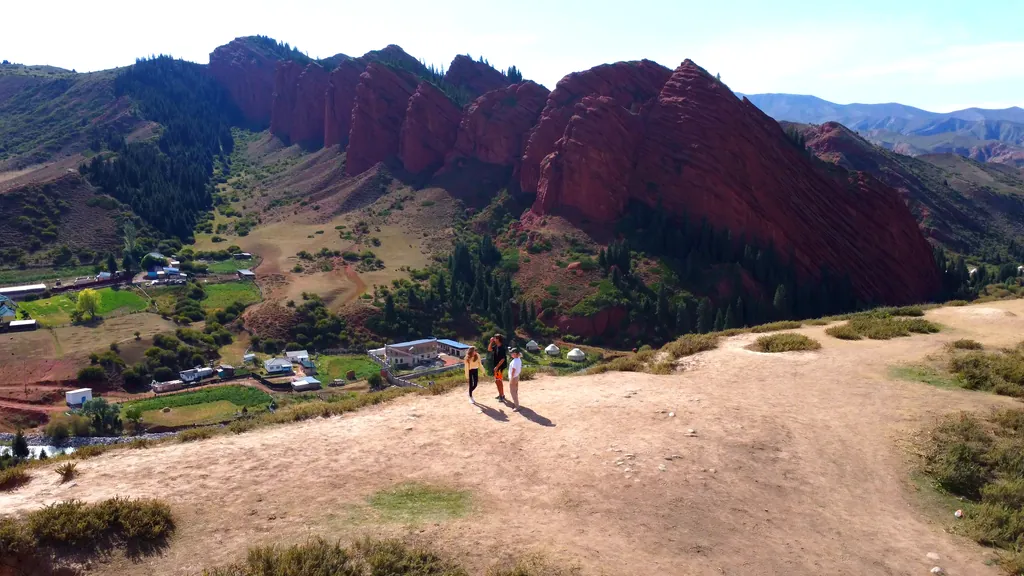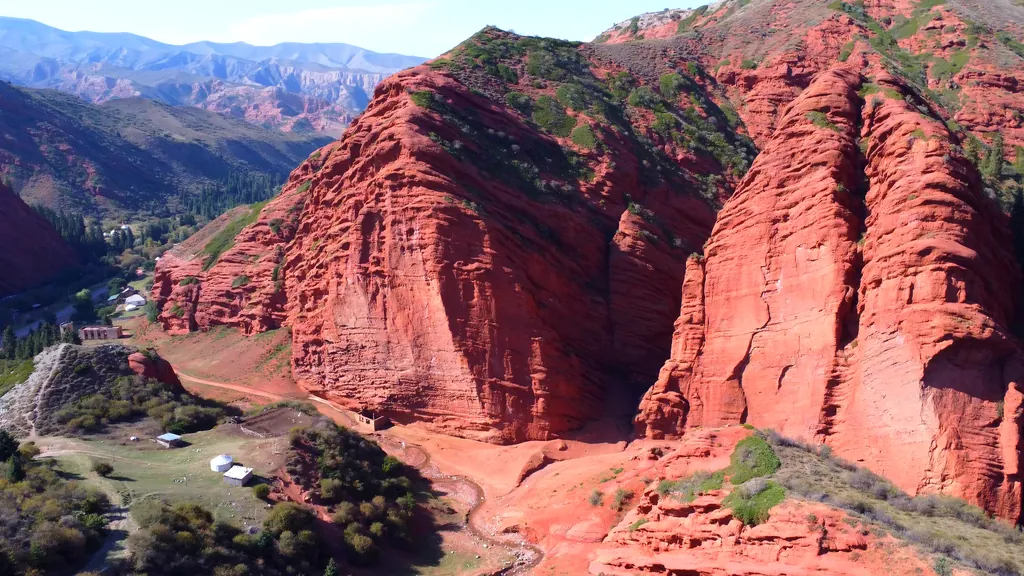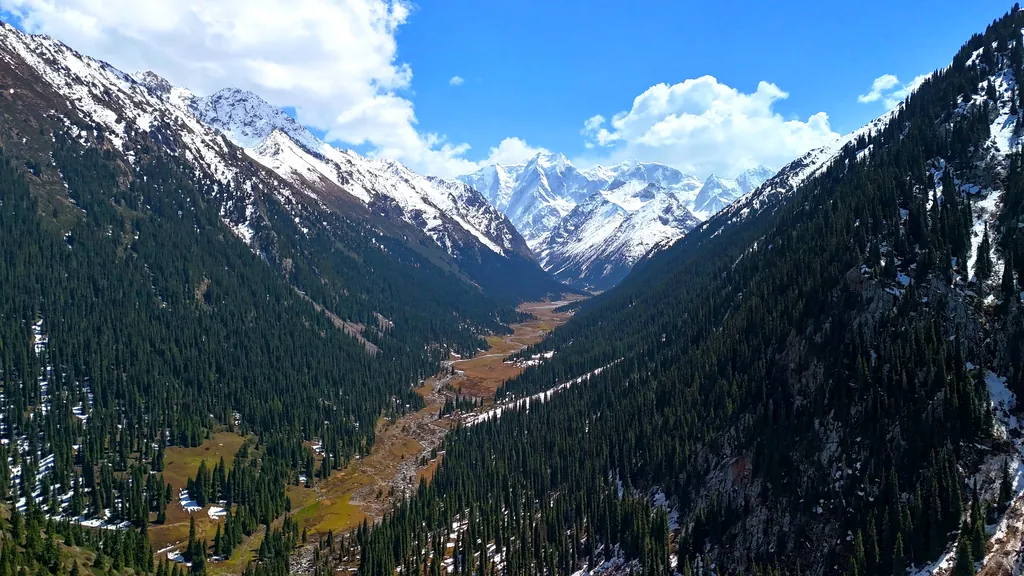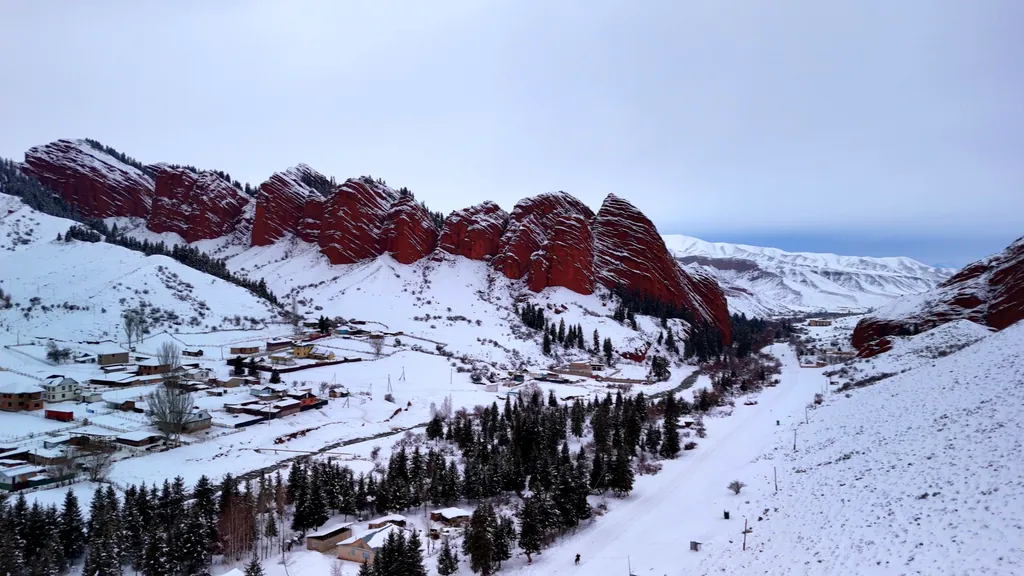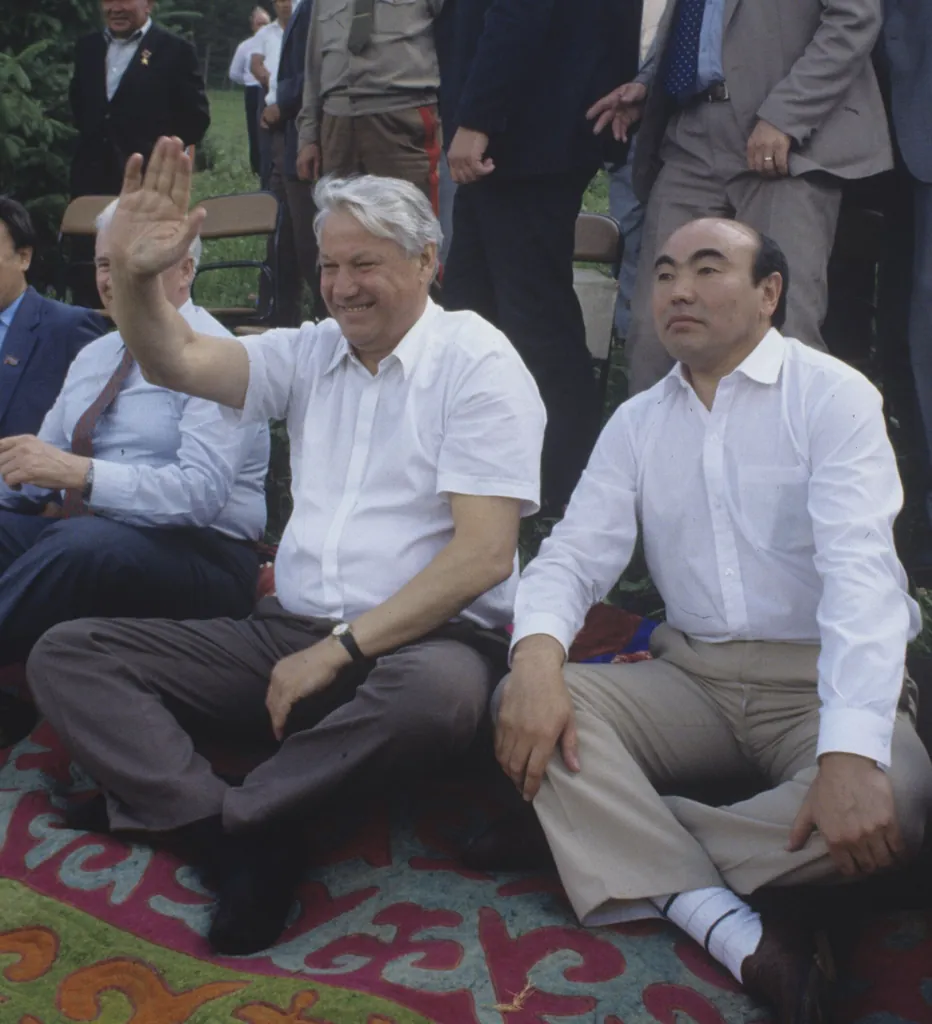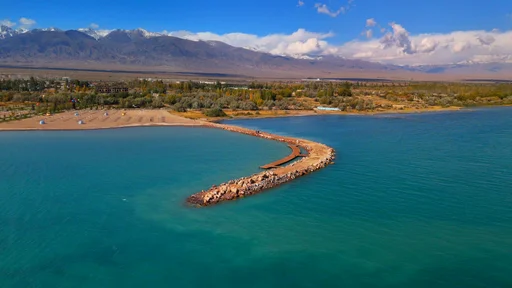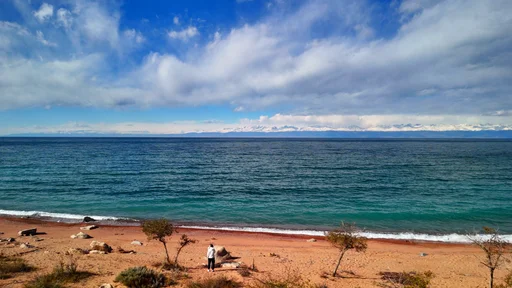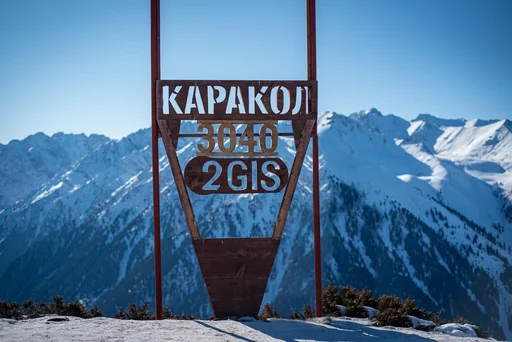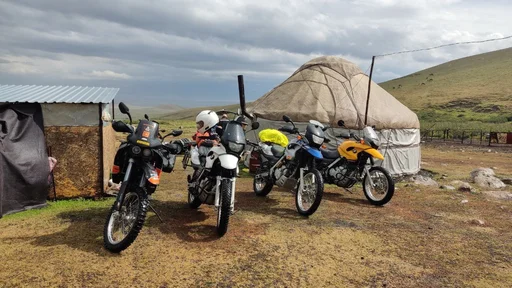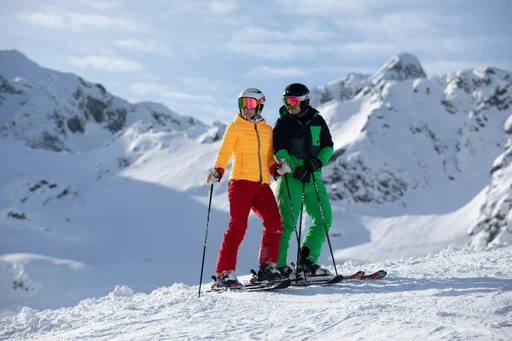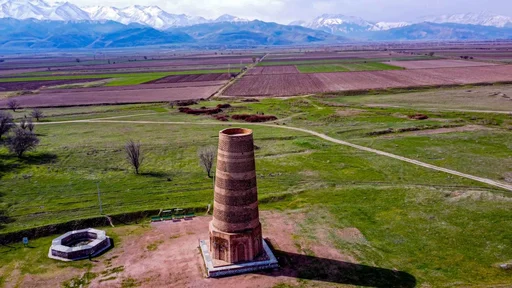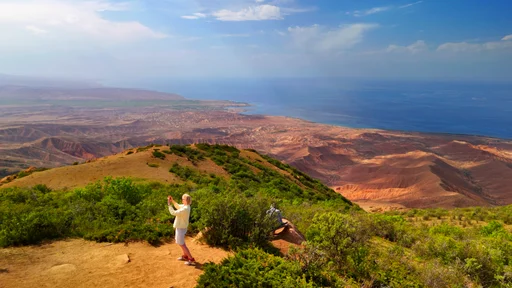Geographical Location and Natural Features
The Jeti-Oguz Gorge (Kyrgyz: Жети-Өгүз - “Seven Bulls”) is located on the southern shore of Lake Issyk-Kul, about 25-30 km southwest of the city of Karakol in the Issyk-Kul Region of Kyrgyzstan. It cuts through the northern slopes of the Terskey Ala-Too range, which encircles the lake to the south. This is one of the most picturesque sites in the country and a specially protected natural monument. The mountain gorge stretches for approximately 37 km, and its valley lies at an altitude of around 2,200 m above sea level. The Jeti-Oguz River flows along the valley floor and feeds into Lake Issyk-Kul. The slopes are covered with coniferous forest (Tian Shan spruces) and lush subalpine meadows. In spring and summer, the slopes bloom with millions of alpine flowers and dandelions, turning the valley into a true “valley of flowers.”
The climate in Jeti-Oguz is moderately cool and mountainous: summers feature mild, pleasantly warm days (averaging +20…25 °C) and cool nights, while winters are snowy and frosty at higher elevations. The best time to visit is late spring and summer, when the passes are free of ice and the mountain pastures are carpeted with grass. During this period, the gorge delights visitors with its combination of blue skies, green meadows, and red cliffs. Due to the proximity of the warm waters of Lake Issyk-Kul, the valley’s climate is milder than other parts of the Tien Shan; however, mountain weather remains changeable: brief showers can occur, especially in June. Tourists appreciate the fresh mountain air and the purity of the Jeti-Oguz River, which originates from glaciers deep within the range.
The gorge’s fauna is rich and varied. Rare and Red List species inhabit the surrounding mountains: snow leopards, ibex (Capra sibirica), bears, and roe deer. Pheasants, wood grouse, black grouse, griffon vultures, and golden eagles are also found. Observant travelers may spot animal tracks near the river in the morning or see birds of prey soaring above the red cliffs. The natural diversity, mild foothill climate, and majestic scenery make Jeti-Oguz attractive to eco-tourists and wildlife photographers.
Geology and Origin of the Rock Formations
The gorge’s main feature is the chain of vividly red cliffs that give it the name “Seven Bulls.” These monolithic rock formations consist of Tertiary-period sand-clay conglomerates and sandstones, formed approximately 25-5 million years ago (Late Oligocene-Miocene). Millions of years ago, the site of the modern gorge was a foothill plain with river channels depositing layers of reddish-brown sedimentary rocks. Tectonic forces uplifted and tilted these layers, and subsequent weathering and erosion exposed them and sculpted their current bizarre shapes. The bright red color of the cliffs comes from high iron oxide content, making the bluffs appear to glow in the sun. The Jeti-Oguz cliffs are a protected geological monument - a unique example of exposed tertiary red conglomerates.
The “Seven Bulls” complex is a rocky ridge at the gorge’s entrance, truly resembling the silhouettes of seven giant bulls lying side by side. The height of these sheer cliffs reaches tens of meters, and the entire red ridge extends about 35 km. The cliffs are composed of alternating layers of loose stone and clay, which wind and rain have carved over centuries into natural “niches” and shapes reminiscent of animals. The “Broken Heart” - another iconic formation at the very start of the valley - is a standalone red rock that resembles a split heart. This formation stands out with its scarlet hue and smooth, stratified surface texture, creating a striking contrast against the surrounding greenery. Geologists believe it formed from the same rock as the “Seven Bulls,” with fractures and erosion of softer surrounding material causing the monolith to split into two parts while maintaining its characteristic heart-like shape.
Today, Jeti-Oguz serves as an “open-air museum” for geology enthusiasts. In the exposed cliff faces, one can observe alternating layers of gravel, sand, and clay. In similar deposits in neighboring areas, scientists have found fossils of ancient animals (such as the giraffid Samotherium and various gazelles), reptiles, and even plant imprints, making the gorge’s environs valuable to paleontologists. While the “Seven Bulls” are primarily appreciated for their scenic beauty, their geological origin offers a window into the distant past of the Tien Shan. In 1975, the Jeti-Oguz cliffs were declared a natural monument to preserve this unique formation for future generations. Thus, the red bluffs not only please tourists’ eyes but also hold scientific significance, revealing the layered history of Central Asia’s mountain landscape.
Legends and Myths of Jeti-Oguz
Since ancient times, folklore has endowed the Jeti-Oguz cliffs with magical tales. Several legends explain the origin of the red cliffs and the “Broken Heart” formation, passed down by Kyrgyz akyns and elders. One of the most famous tells of two feuding khans who once lived in these mountains. One kidnapped his neighbor’s beautiful wife, sparking a bloody war. Neither ruler wanted to relent. The kidnapper then resorted to a cunning ruse: he held a seven-day feast, sacrificing a bull each day, and on the seventh day, he also killed the woman. Legend says that where her blood droplets fell, seven huge crimson rocks petrified. Thus the valley was named Jeti-Oguz - “Seven Bulls.” From the grief and atrocity, one participant’s heart shattered into stone at the valley’s entrance, giving rise to the “Broken Heart” rock. The treacherous khan, according to legend, was swiftly punished when thunder roared and floodwaters swept away his army. This poignant legend warns of the price of betrayal and still imbues Jeti-Oguz’s red cliffs with a mystical aura.
Other tales also link the red cliffs to dramatic events. In one legend, a greedy bey lost his seven best bulls on a summer pasture. Tasked warriors searched the gorge until they saw on the opposite bank seven rock-like bulls. When wolves attacked the bulls, they stood shoulder to shoulder, bowed their heads, and from terror turned to stone - ever since, they stand as the seven red rocks. In another version, seven brothers fought over inherited cattle, resorted to deadly combat, and a powerful shaman turned the bulls to stone to stop fratricide, preserving them as seven blood-red boulders. These variations underscore unity’s value and the dangers of discord.
Separate myths revolve around the “Broken Heart” rock, whose appearance inspires romantic lore. One popular legend recounts a maiden courted by two best friends. Unable to choose, the suitors fought a duel over her hand, both perishing in a tragic contest. Consumed by guilt, the maiden plucked out her heart, and it turned to stone on the mountain - hence the rock that cleaves in two. Another story tells of a cruel khan who abducted a poor bride-to-be promised to her beloved. The bride died of heartbreak on her journey, and her split heart became the red rock at the gorge’s mouth. All versions agree: this rock symbolizes a broken heart, representing tragic love and everlasting remembrance. Unsurprisingly, the “Broken Heart” draws couples seeking to pledge true love, for legend has it that a sincere wish spoken here will be granted.
Today guides delight visitors with these ancient tales. The legends of Jeti-Oguz not only explain the cliffs’ unusual shapes but also add an element of enchantment and mystery to any visit. Hearing them beneath the “Seven Bulls” at sunset, one is filled with admiration for the power of folk creativity to enliven the mountains with ancestors’ imagination and wisdom. Myths of the Jeti-Oguz valley are now part of its appeal, making a visit feel like stepping into a magical Tien Shan fairy tale.
Historical Information and Significance of the Gorge
Beyond its natural wonders, Jeti-Oguz Gorge is rich in historical and cultural relics. At the junction of nomadic routes, people have inhabited the area since the earliest times. Burial mounds from the early Iron Age (7th-5th centuries BC) have been found nearby - several large kurgans measuring 16-28 m in diameter and about 2-3 m in height. Although eroded over time, these mounds were once even more imposing. Archaeologists attribute them to the Saka-Scythian period and believe they mark the graves of noble nomads or warriors. The presence of these kurgans indicates that the valley has long served as a convenient camp and pasture site, as well as holding ritual significance for ancient peoples. One could say that Jeti-Oguz has witnessed the footsteps and horse hooves of many nomadic generations crossing the Tien Shan.
In more recent times, the gorge has also played its part in history. In the early 20th century, after Kyrgyzstan’s incorporation into the Russian Empire, explorers and scientists studied the valley. Local legends were recorded by the Russian writer Ivan Sokolov-Mikitov, who visited in the 1920s. During the Soviet era, around 1932, the balneological resort “Jeti-Oguz” was established in the heart of the gorge - a health spa utilizing the valley’s hot springs. The sanatorium was built near the red cliffs at an elevation of ~2,200 m and quickly gained renown for its radon-rich waters and therapeutic muds. Soviet workers and academics were sent here for recuperation, and in the 1970s, the gorge even hosted cosmonaut training - literally. Several early Soviet cosmonauts (including A. Eliseev, N. Rukavishnikov, V. Aksyonov, V. Lebedev) spent month-long training camps here. They lived at the Jeti-Oguz sanatorium and trained daily on the flowering meadows of Kok-Jayyk, under medical supervision. The Institute of Medical and Biological Problems conducted these programs to test whether high-altitude training could speed recovery from overloads. Cosmonauts hunted, fished, and breathed the healing mountain air. Plans to build a full training base here were later abandoned in 1974 in favor of Tamga, another climate-optimal Issyk-Kul site. Nonetheless, the memory remains: the meadow where a few wooden guest houses now stand is still called the “Cosmonauts’ Glade,” although those houses date from the 1990s. The fact that space pioneers trained in Jeti-Oguz adds a unique historical allure to the gorge.
Another notable event took place here at the end of the Soviet era. In August 1991, at the Jeti-Oguz sanatorium, Kyrgyzstan’s first president, Askar Akayev, and the President of the RSFSR, Boris Yeltsin, held talks. The leaders met in the gorge’s scenic setting just after Kyrgyzstan declared sovereignty. This meeting became known as the “Issyk-Kul Forum,” symbolizing peaceful dialogue in the post-Soviet period. To commemorate the occasion, one of the towering peaks at the valley’s head (Oguz-Bashi, 5,168 m) was renamed Peak Yeltsin. Thus, Jeti-Oguz was inscribed in the political history of the young republic.
Today, the gorge continues to play an important role - as a major tourist and cultural attraction. It is a source of local pride and frequently appears in songs, poems, and paintings by Kyrgyz artists. Images of the “Seven Bulls” grace souvenirs, tourism company logos, and postcards. In 1968, the red cliffs even featured on a Soviet postage stamp, underscoring their status as a symbol of Kyrgyzstan’s natural heritage. Jeti-Oguz’s historical legacy - from Scythian kurgans to Soviet sanatoria - makes it not only a scenic wonder but also a kind of open-air history museum, where past and present converge.
Nomadic Culture: Life of Herders and Locals
Jeti-Oguz is not just a natural park but also a living pasture where nomadic life endures in its traditional form. Each summer, with the arrival of warmth, local Kyrgyz herders bring their livestock up into the wide gorge valleys. The green mountain meadows of Kok-Jayyk and other plateaus serve as summer pastures (jayloo), where herders graze flocks of sheep, herds of horses, and cattle. In June, the meadows bloom with red poppies, earning the nickname “Valley of Flowers.” Herders set up temporary camps: traditional round felt yurts for their families, and around them horses graze and sheep bleat. These mobile encampments usually consist of several yurts, where the herder’s family lives and where food and dairy supplies are stored.
For many families in nearby villages, summer grazing in Jeti-Oguz is a way of life. In spring, when mountain pastures green up, they drive their herds from winter quarters to abundant alpine meadows. They stay here until the cold returns, living simply away from towns. In the evenings, the valley echoes with shepherds’ calls and barking dogs, and at dawn, one sees the herdsmen milking mares. From fresh mare’s milk they make kumys - a fermented dairy drink famed for its healing properties. They also prepare ayran (soured milk) and kaymak (cream), and from sheep’s milk produce kurt cheese. Tourists who visit the gorge in summer have a rare chance to experience modern nomadic life: herders often invite guests into their yurts to sample kumys and share their customs.
In the Kok-Jayyk Valley, midway along Jeti-Oguz, entire yurt villages spring up each summer. These are ethnographic camps akin to eco-camping sites for travelers. One such camp - Nomad Lodge - operates year-round, offering guests stays in authentic felt yurts with modern comforts. In summer, dozens of yurts can stand here: some belonging to herders, some catering to tourists. White yurts dot the valley, horses roam free, and children tending flocks pass by on horseback. The scene changes little from that of centuries past, save for solar panels or modern tents among the yurts. Yet herders preserve their traditions: inside each yurt lie brightly patterned shyrdak carpets, women prepare boorsok (fried flatbread) and plov over the hearth, and men repair harnesses or play the komuz.
For tourists, experiencing life on the jayloo is one of Jeti-Oguz’s most vivid impressions. Local shepherds gladly offer guests horseback rides through the surroundings - perhaps to a nearby waterfall or up to vantage points overlooking the valley. Shepherds act as impromptu guides: showing trails, pointing out marmot burrows, or introducing the boldest horses in the herd. Such informal interaction provides an intimate glimpse of Kyrgyz nomadic culture - its hospitality, hard work, and reverence for nature. Many travelers note that a cup of fresh kumys sipped in the cool of a yurt or an evening by the campfire under Jeti-Oguz’s endless starry sky captures the spirit of nomadic life.
In nearby settlements (the villages of Jeti-Oguz and Kyzyl-Suu), descendants of these herders live year-round. In these villages, small local history museums and craft fairs showcase felt carpets, woolen socks, carved wooden saddles, and other folk creations. Thus, a trip to Jeti-Oguz is also an ethnographic tour, allowing visitors to see firsthand the synthesis of nature and traditional Kyrgyz culture.
Tourism in the Valley: Routes, Trekking, and Hot Springs
Thanks to its beauty and accessibility, Jeti-Oguz Gorge has become a popular eco-tourism destination. The valley offers numerous routes for visitors, from short walks to multi-day treks. Most guests begin at the gorge entrance, where the “Broken Heart” and “Seven Bulls” cliffs are located. Viewing platforms and parking areas are available here, offering excellent vantage points of the red bluffs. Tourists pose before the “Broken Heart,” and many couples even hold symbolic engagements at this romantic spot - the gorge’s “calling card.” Interestingly, after rain, water streams through the cracks in the rock, staining it with red clay; capturing this moment in a photo can be truly extraordinary - like a bleeding stone heart.
Continuing deeper along the gorge - the road follows the river, crossing wooden bridges from bank to bank - tourists soon reach the Jeti-Oguz resort area. This famed spa, established during the Soviet era, is known for its hot springs. Visitors can bathe in thermal pools or take radon baths. Jeti-Oguz’s mineral-rich waters are chloride-sodium-calcium radon springs with temperatures of +37…+42 °C. Slightly radioactive and rich in trace elements (bromine, iodine, boron, etc.), the water provides therapeutic benefits. The sanatorium offers treatments for musculoskeletal and nervous disorders, gynecological conditions, and uses mud therapies. In addition to bathing, guests can drink the mineral water to aid digestion. Surrounded by a picturesque pine forest, visitors breathe the healing air. Every year, thousands from Kyrgyzstan and neighboring countries come to Jeti-Oguz for health and leisure. For those uninterested in medical procedures, the resort serves as a starting point for many hiking trails.
One popular excursion is the hike - on foot or horseback - to the “Maiden’s Tears” waterfall (also called “Maiden’s Locks”). This 20-meter cascade lies about 3 km west of the sanatorium, on a side tributary of the Jeti-Oguz River at an altitude of around 2,500 m. The trail winds through dense spruce forest and alpine meadows before the water cascades like loose tresses down the cliff. The best time to visit the waterfall is summer when the path is dry and safe. The hike to the “Maiden’s Tears” takes about an hour on foot from the road, making it a favorite for families with children. Local guides offer horseback rides to the waterfall - a colorful option for those seeking an authentic experience. Riders pass flowering meadows and ford mountain streams before enjoying a picnic by the cool cascade. Visiting this waterfall offers a chance to immerse oneself in pristine mountain nature.
Another must-see on many itineraries is the Kok-Jayyk Valley (Valley of Flowers), located about 5 km from the sanatorium at an elevation of ~2,000-2,200 m. A gravel road runs alongside the river to reach it. In spring and early summer, Kok-Jayyk is carpeted with red poppies, hence its name. In summer, numerous yurt camps are set up here (as described above), making it an ideal overnight stop. Many organized tours from Karacol include yurt stays in Kok-Jayyk, where guests enjoy traditional meals around the campfire and gaze at the starry sky far from light pollution. From the valley, one of the region’s most popular treks begins - to high-mountain Ala-Kul Lake. This moderate trek usually takes 3-4 days, crossing the Telet Pass (3,800 m) into the Kara-Kol River valley and then up to the scenic Ala-Kul Lake (3,538 m). The route demands good fitness but is highly popular with both foreign and local tourists: along the way, hikers encounter glaciers, conifer forests, and alpine meadows, and the lake’s turquoise waters framed by snowy peaks are truly spectacular. In Jeti-Oguz, trekkers can hire professional guides and equipment, and part of the journey can be done on horseback to ease the ascent. Accommodations are typically tents or mountain huts, with provisions provided by guides.
Beyond the Ala-Kul trek, Jeti-Oguz offers many other hikes and climbs. At the valley’s head stands the Oguz-Bashi massif (5,168 m) - a twin-peaked snow-capped mountain that closes the gorge and is visible from afar. Experienced alpinists ascend Oguz-Bashi and surrounding summits (Kok-Debe, Dzhigit, Teleti, etc.). For those seeking gentler walks, trails lead to Lake At-Jayloo and the Kok-Jayloo waterfall on tributaries, as well as side excursions to passes like Kashka-Suu. Stunning panoramas await: from any vantage, one sees red canyons stretching to the horizon and the snowy spires of the Terskey Ala-Too under a cerulean sky. Photographers and artists flock here for its vivid colors. At dawn, the red cliffs glow under the first sunlight; by day, the emerald pines cast lacy shadows on the scarlet bluffs; at dusk, snowcaps catch the pink hues of sunset.
Active tourists have more options nearby: mountain biking on gravel roads, birdwatching in forests home to rare species, and in winter - when the upper gorge may be snowbound - the lower reaches become venues for backcountry skiing and snowshoeing. Some enthusiasts mount freeride descents on untouched slopes, making Jeti-Oguz a year-round adventure destination offering everything from gentle walks to extreme alpine ascents.
Infrastructure: Roads, Accommodation, and Tourist Amenities
Reaching Jeti-Oguz Gorge is straightforward - one reason it’s so popular for day excursions from Karacol. The road from Karacol to the gorge’s entrance is about 30 km: half the journey is on a paved highway along Issyk-Kul’s southern shore, then near the village of Jeti-Oguz a side road leads into the mountains. The village of Jeti-Oguz lies close to the gorge’s mouth; it is a sizable settlement (the district is named after the gorge). From the village, a gravel track runs several kilometers to the resort and then follows the river. In summer, minibuses run from Karacol to Jeti-Oguz village on a limited schedule, so many travelers hire a taxi or private driver. The drive takes around 40-50 minutes. Organized groups can book minibuses that go directly to campsites deeper in the valley. Note that beyond the resort, the road deteriorates: wooden bridges cross the river and, after rain, only 4x4 vehicles can continue. Therefore most tourists leave their cars at the sanatorium or near the “Broken Heart” and explore the main attractions on foot.
Accommodation in Jeti-Oguz is also easy to find. Where you stay depends on your travel style. For short visits, many base themselves in Karacol and drive to the gorge for the day (either on guided tours or by rental car). However, many prefer to stay within the valley itself to experience its ambiance at dawn and dusk. The simplest option is the Jeti-Oguz sanatorium at the gorge entrance, offering hotel rooms alongside therapeutic facilities. This Soviet-era resort provides basic amenities, a dining hall with diet meals, and the therapeutic climate and hot springs just a 5-10 minute walk from the iconic cliffs. Local guesthouses in Jeti-Oguz village offer home-style stays and meals. Some inns are within the valley, about a 15-minute drive from the “Seven Bulls.”
For ethno-tourism and solitude seekers, the aforementioned yurt camps in the Kok-Jayyk valley are ideal. In season (June to early September), dozens of yurts welcome guests. Many tour operators offer packages that include yurt accommodations - such as Nomad Lodge, which maintains 10 comfortable yurts year-round equipped with beds, stoves, and even wood floors. Meal service typically features national cuisine - boorsok, lagman, fresh kurt - in a dedicated yurt-restaurant. Facilities may be outdoors (eco-toilets, summer showers), and electricity is supplied by generators at night. Yet to many, spending the night in a yurt by the mountain river is an unforgettable experience. Access varies: some camps are reachable by car, others require packing equipment on horses and trekking. Beginners should choose camps near the gorge entrance or hire guides for more remote hikes.
It’s important to note that Jeti-Oguz’s tourist infrastructure is developing while remaining unobtrusive and eco-friendly. At the gorge entrance, informational boards (in Kyrgyz, Russian, and English) display trail maps, legends, and conduct guidelines. Horse rental points line the road, and locals sell honey, kurt, and felt and wood souvenirs. Some yurt villages even feature traditional smoke saunas. Mobile reception may drop deep in the valley, so hikers are advised to inform rescue services of complex routes. Overall, Jeti-Oguz has long been frequented by travelers of all types - from leisure drivers enjoying coffee by the “Broken Heart” and returning to Karacol for dinner, to backpackers embarking on week-long mountain adventures. Each finds something special - therapeutic waters and tranquility, the thrill of conquering passes, or the warmth of a nomadic hearth.
Picturesque Scenery and Popular Photo Spots
Jeti-Oguz Gorge is renowned for its breathtaking scenery, attracting photographers and nature lovers. The interplay of red cliffs, green forests, and snowy peaks against a high sky creates truly dramatic vistas. It’s no wonder the valley is often called one of Kyrgyzstan’s most photogenic locations. Each area offers unique angles and moods, from the soft hues of dawn to the fiery colors of sunset illuminating the “Seven Bulls.”
The most popular photo spots lie at the valley’s entrance. First is the “Broken Heart” rock - an almost mandatory backdrop for all visitors. Its perfect heart shape is best captured from a small rise by the road, with travelers posing hand-in-hand in front of the “heart.” The changing light through the day highlights the rock’s hues - bright crimson at midday, deep burgundy at dusk. After rains, streams of red clay trickle down the surface, creating “bleeding heart” shots that appear truly surreal. Images of the “Broken Heart” and “Seven Bulls” adorn postcards and travel brochures, and every visitor aims to capture their own image of this natural wonder.
Second, the red cliffs of the “Seven Bulls” themselves are the star of many landscape shots. To capture the entire ridgeline, it’s best to step back along the road or climb the opposite slope. From hills across the valley, one gets a panorama with meadows and the winding river in the foreground, red cliffs rising beyond, and green foothills further back. This view is particularly striking at sunrise or sunset, when one side of the cliffs is bathed in light and the other lies in shadow. In summer, green grass contrasts vividly with scarlet rock; in winter, white snow atop the cliffs creates a graphic alternating pattern. Photographers often note that the gorge’s vibrant colors rival the famed canyons of Utah and Arizona.
Deeper into the valley, visitors encounter alpine panoramas. The Kok-Jayyk Valley in spring becomes a sea of red poppies - perfect for photographers: close-ups of delicate blooms and sweeping vistas framed by snowy summits. No wonder it’s called the “Valley of Flowers.” Nearby, the Maiden’s Tears waterfall and its surrounding emerald spruce forest and tumbling waters offer opportunities for long-exposure “silky water” shots: white cascades against dark rock and lush greenery make stunning compositions.
At shepherds’ camps, one can capture authentic ethnographic images: white yurts against the valley backdrop, grazing horses, shepherds guiding livestock at dusk - scenes worthy of a photo essay. Many tourists enjoy horseback portraits in traditional Kyrgyz ak-kalpaks (felt hats). At night, the gorge’s remote location offers unparalleled stargazing and astrophotography - especially the Milky Way shimmering over silhouetted yurts.
On clear days from the central valley floor, distant snowy peaks of the Terskey Ala-Too range are visible. From certain vantage points, one can even spot Oguz-Bashi - a dual-peaked summit compared to a bull’s horns - rising between ridges. Experienced landscape photographers frame red cliffs in the foreground with the white-capped Oguz-Bashi (renamed Peak Yeltsin) in the background, symbolizing Kyrgyzstan’s layered landscapes - from fiery canyons to icy heights.
Interesting Facts About Jeti-Oguz Gorge
Natural Symbol on a Postage Stamp: The red cliffs of Jeti-Oguz gained fame during the Soviet era - in 1968, they were featured on a USSR postage stamp. Later, in 1995, the “Seven Bulls” appeared on one of Kyrgyzstan’s first independent postal issues, underscoring their status as a national symbol.
Cosmonauts on the Jayloo: In the 1970s, Jeti-Oguz valley served as a training site for Soviet cosmonauts. Space heroes (including A. Eliseev and N. Rukavishnikov) spent month-long camps here, living at the sanatorium and training on the high-altitude meadows of Kok-Jayyk.
High-Level Meeting: In August 1991, just after the USSR’s dissolution, Jeti-Oguz hosted talks between Kyrgyz President Askar Akayev and RSFSR President Boris Yeltsin. This informal mountain meeting, set against the gorge’s beauty, symbolized the peaceful separation of republics. To mark the occasion, Oguz-Bashi peak (5,168 m) was renamed Yeltsin Peak.
The “Bleeding Heart” of Legend and Nature: The “Broken Heart” rock is tied not only to legend but also to a striking natural phenomenon. After heavy rains, water seeps through rock layers, emerging stained with red clay. The streams tracing the rock’s face give the appearance of a bleeding stone heart, enhancing the site’s mystical allure and drawing couples who believe that shed tears will strengthen their love.
A Gem for Conservationists: Jeti-Oguz Gorge is not only a popular tourist destination but also a valuable nature reserve. Rare species such as snow leopards and Tibetan brown bears live in the remote corners, and endemic plants flourish here. The valley forms part of the UNESCO-designated Issyk-Kul Biosphere Reserve, highlighting its global ecological importance. Visitors are reminded to follow a “leave no trace” ethic - no littering, no disturbing wildlife, and respect for the fragile mountain environment.
Новости по теме

